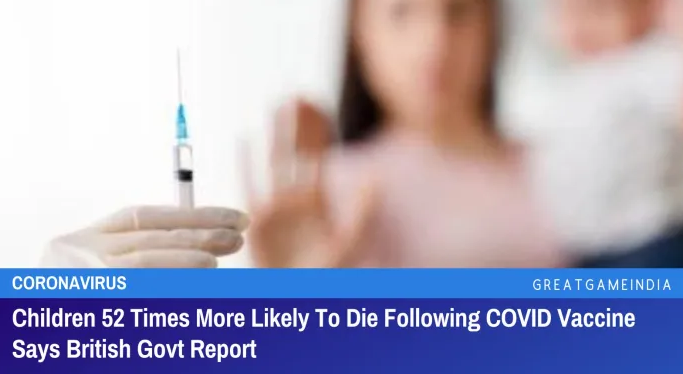The British government reports claim that children are 52 times more likely to die following COVID vaccine. Mortality rates were even greater among individuals who took two doses of the COVID vaccine in both young age groups.
Children 52 Times More Likely To Die Following COVID Vaccine Says British Govt Report
The Office for National Statistics (ONS) in the United Kingdom has revealed statistics showing that children who took the COVID-19 vaccine had a 54-fold higher death rate than their un-jabbed equivalents.
The ONS released age-standardized statistics on the mortality rates of people in 5-year age groups in the United Kingdom in December, classified by their “vaccination” status for the COVID-19 doses. The data covers the period from January 1, 2021 to October 31, 2021.
The ONS calculated “monthly age-standardised mortality rates by age-group and vaccination status for deaths involving COVID-19, per 100,000 person-years,” but only for people aged 18 and up. The jabs, meanwhile, are accessible to youngsters as young as 12, and those children are permitted to obtain the shot over the will of their guardians. In a few occasions, kids as young as 5 have received a lesser dose of the shots.
Nonetheless, as The Exposé points out, a second chart summarising “deaths and person-years by vaccination status” covers 5-year age groupings ranging from 10-years-old and above. The death rate per 100,000 person-years can be calculated using the data provided.
The rate per 100,000 person-years demarcation is preferred over the simpler 100,000 population calculation to better portray death rates over time, as individuals in one “vaccination” group – such as un-jabbed, single-jabbed, and double-jabbed – quickly migrate into the next.
The ONS report’s Table 9 displays “deaths and person-years by vaccination status and five-year age group” for the whole ten-month timeframe. As per the data, the un-jabbed 10–14-year-old age group accounts for 2,094,711 person-years, while the 15–19 age group accounts for 1,587,072 person-years during that same time period.
The 100,000 person-years estimate may be conducted using the above table, with the younger crowd turning out at 20.9 un-jabbed per 100,000 person-years and the older demographic coming out at 15.9. The fatality rate per 100,000 person-years is then calculated by dividing the amount of fatalities inside every category by the 100,000 person-years estimate.
As a consequence, the un-jabbed death rate per 100,000 person-years for the 10–14 year range is 4.6, whereas the un-jabbed mortality rate per 100,000 person-years for the 15–19 year category is 10.1.
Employing the identical set of data and computation, 10–14-year-olds who obtained one dosage of the jabs died at a frequency of 45.1 per 100,000 person-years, whereas 15–19-year-olds with one jab died at a rate of 18.3 per 100,000 person-years.
Mortality rates were even greater among individuals who took two doses of the COVID vaccine in both young age groups, with 32.9 deaths per 100,000 person-years among 15–19-year-olds and a shocking 238.4 fatalities per 100,000 person-years among 10–14-year-olds in the United Kingdom.
The statistics demonstrate a significant upsurge in fatalities amongst single- and double-jabbed youngsters as opposed to their un-jabbed equivalents. The likelihood of death nearly doubles for children aged 15–19 should they consume the first shot and more than triples if they take the second.
10–14-year-olds, however, are almost ten fold more likely to die after the first dosage, and the second treatment is 51.8 times more likely to kill them than if they had stayed un-jabbed.
In general, children aged 10 to 19 who had taken at least one dose of the COVID vaccine had a 3.7-fold increased risk of dying between January and October of last year.
Furthermore, as per the ONS’ “five-year average weekly deaths by sex and age group” numbers between 2015 and 2019, documented deaths amongst kids aged 10-14 have increased by 44 percent over the average in weekly statistics supplied by the ONS for 2021.
In a statement issued on September 3, the JCVI, a external consultant to the UK government on immunization programs, found that “available evidence indicates that the individual health benefits from COVID-19 vaccination are small in those aged 12 to 15 years.” They went on to say that just about any advantage provided by the injections is only “marginally greater than the potential known harms,” and that “there is considerable uncertainty regarding the magnitude of the potential harms.”
Considering the ambiguity about the hazards associated with the COVID vaccinations, the JCVI deemed the advantages “too small to support advice on a universal programme of vaccination of otherwise healthy 12- to 15-year-old children at this time.”
Furthermore, there has never been proof that COVID vaccination studies have resulted in proof that the vaccines halt illness or spread. They do not even promise to reduce hospitalisation, however the effectiveness is measured by reducing severe COVID-19 illness signs. Nevertheless, there seems to be significant evidence that the “vaccinated” are equally as prone as the unvaccinated to harbor and spread the virus.












